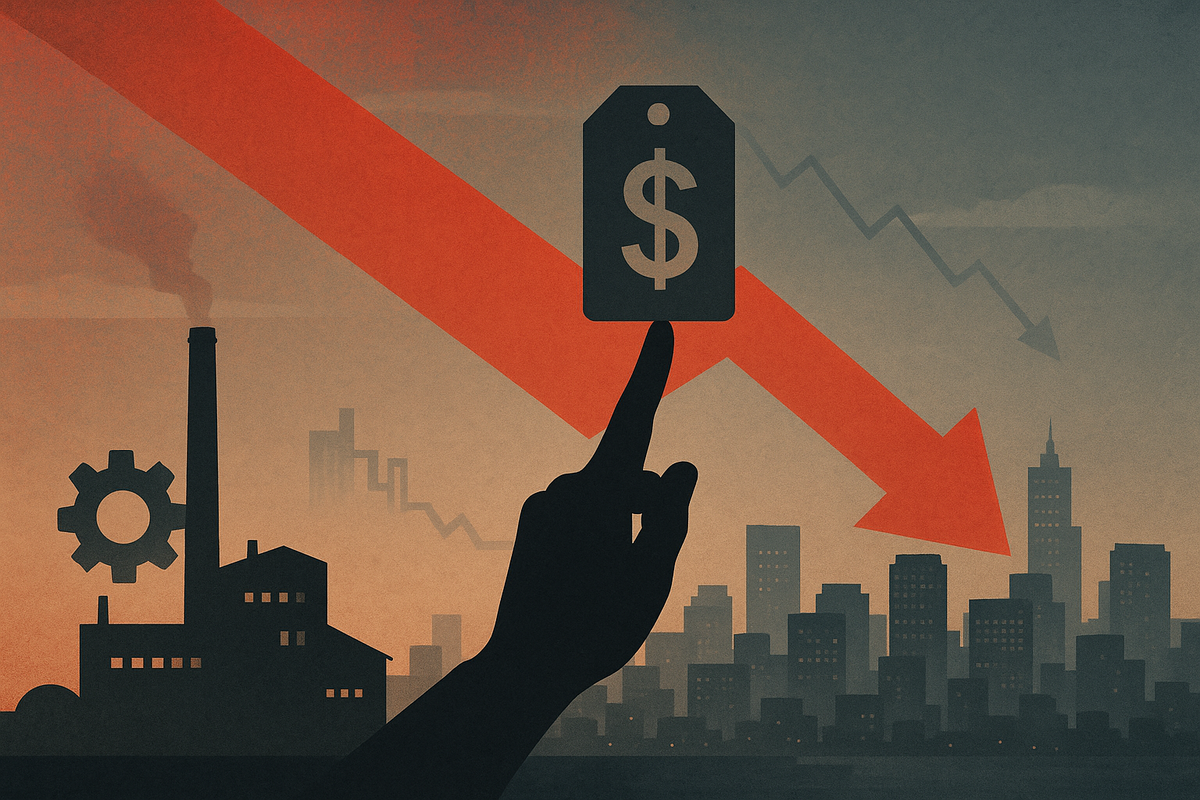
U.S. business activity experienced a notable slowdown for the second consecutive month in September 2025, according to the latest Flash US PMI data. The S&P Global US PMI Composite Output Index, a key gauge of economic health, dipped from 54.6 in August to 53.6, marking a three-month low. This moderation signals a cooling in the pace of economic expansion, raising questions about corporate margins, future inflation trends, and the Federal Reserve's monetary policy stance amidst persistent tariff pressures and softening demand.
The report highlights a challenging environment where businesses grapple with elevated input costs, largely attributed to tariffs, while simultaneously facing weakened demand that limits their ability to pass on these costs through higher selling prices. This dynamic suggests a potential squeeze on corporate profitability and could influence investment and hiring decisions in the coming months.
What Happened and Why It Matters: A Deeper Dive into the Slowdown
September's Flash US PMI data paints a clear picture of an an economy losing some of its recent momentum. The Composite Output Index's fall to 53.6, though still indicative of expansion, signifies the weakest growth rate since June. Despite this deceleration, the third quarter as a whole still represents the strongest average monthly expansion since the end of 2024, suggesting a robust but moderating economic trajectory, consistent with an estimated 2.2% annualized GDP growth rate for Q3.
Both the manufacturing and service sectors contributed to this slowdown. In manufacturing, the PMI eased to 52.0 from 53.0, indicating a softer rate of improvement. Output growth, while positive, was significantly less robust than the 39-month high seen in August. New orders increased only marginally, partly due to increased losses of exports linked to tariffs. Compounding this, slower than expected sales led to the largest rise in factory inventory levels of unsold stock in the survey's history, a potential precursor to future production cuts. The service sector also saw its Business Activity Index fall to 53.9 from 54.5, marking its weakest growth since June. New orders here recorded their smallest rise in three months, as weaker domestic demand growth largely offset the first rise in exports since March.
A concerning trend emerging from the report is the weakening rate of job creation across both sectors. While service companies continued to add staff, there was a higher incidence of firms reporting being "unable or unwilling to fill vacant positions." In manufacturing, the focus shifted more towards job losses as a result of cost-cutting measures. This suggests a cautious approach to employment amid economic uncertainty.
Crucially, tariffs were identified as the primary driver of sharply higher input costs. Manufacturing input price inflation remained elevated, among the highest rates since the pandemic, while service sector input price inflation hit its second-highest level in 27 months. Overall, input cost inflation accelerated to its highest point since May. However, the report also noted that weaker demand and intense competition limited businesses' ability to raise selling prices, which rose at the slowest rate since April. This confluence of high input costs and constrained selling prices points directly to squeezed profit margins for many U.S. companies.
Navigating the Market: Winners, Losers, and Shifting Tides
The latest PMI figures are likely to ripple through financial markets, prompting investors to re-evaluate economic forecasts and corporate outlooks. Historically, a slowdown in business activity can lead to speculation about the Federal Reserve's monetary policy. Weaker PMI data, especially when coupled with moderating inflation in selling prices, could be interpreted as a signal for potential interest rate cuts, which would typically support bond markets (leading to lower yields) and potentially boost rate-sensitive segments of the stock market. Interestingly, business confidence did show improvement in September, partly fueled by hopes that lower interest rates could help mitigate the adverse effects of tariffs and policy uncertainty.
However, the impact will not be uniform across all companies and sectors. Manufacturing firms, particularly those heavily reliant on global supply chains for imported components (such as automotive, electronics, and heavy machinery industries), are likely to be among the hardest hit. They face significant cost increases, with some analyses in 2025 pointing to up to 15% cost hikes on Chinese imports. Export-oriented manufacturers will also struggle due to retaliatory tariffs and a general weakening of global demand. Companies operating in highly competitive markets with already thin margins and facing softer domestic demand will find it particularly challenging to absorb higher input costs without passing them on, leading to significant margin compression. For instance, (John Deere (NYSE: DE)) has historically seen reduced net income and sales due due to tariffs on inputs like steel and aluminum, compounded by lower farmer spending.
Conversely, sectors less exposed to international trade and tariffs might prove more resilient. Domestically focused service industries, while experiencing some slowdown, might fare better than their manufacturing counterparts, especially if consumer spending remains robust in certain areas. Furthermore, if the Federal Reserve does indeed consider interest rate cuts, rate-sensitive sectors like real estate or utilities could see some uplift. The "AI trade," exemplified by companies like (Nvidia (NASDAQ: NVDA)), has been a significant driver of market rallies and may continue to show resilience, as its growth drivers are somewhat decoupled from traditional manufacturing cycles and tariff impacts.
Broader Implications: Tariffs, Policy, and the Path Ahead
The September PMI data underscores a significant shift in the broader economic narrative for the U.S., moving from robust expansion towards a more measured, albeit still positive, growth trajectory. This second consecutive month of slowdown, following a strong Q4 2024 and Q3 2025, suggests that the economy is normalizing, but also highlights underlying vulnerabilities. The persistent impact of tariffs, which have been a recurring theme in economic analyses, continues to be a major drag, increasing factory costs by an estimated 2% to 4.5% and leading to supply chain disruptions and reduced demand for U.S. exports.
These tariff-induced cost increases create ripple effects throughout the economy. For businesses, squeezed margins can lead to a reduction in capital expenditure, a slowdown in innovation, and potentially a stagnation of wages or even layoffs and plant closures if costs become untenable. This could dampen overall economic dynamism and consumer confidence. For consumers, while weaker demand is limiting selling price increases for now, the continued pressure from input costs could eventually translate into higher consumer prices if demand strengthens, or lead to a weaker job market if businesses cut back.
From a policy perspective, the slowing growth and cooling selling price inflation, coupled with the expressed hopes of lower interest rates among businesses, could exert considerable pressure on the Federal Reserve. The central bank may find itself compelled to consider easing monetary policy to support economic activity and counteract the negative economic impacts of ongoing tariffs and trade uncertainties. This aligns with historical precedents where central banks often adjust policies in response to significant economic shifts and external pressures. The unprecedented accumulation of unsold factory inventories also suggests a potential softening of inflation down the line, giving the Fed more room to maneuver.
What to Pay Attention to Next: Navigating the Economic Currents
As the U.S. economy navigates this period of moderation, several key indicators will be crucial for investors and businesses to monitor. In the short term, attention will undoubtedly turn to upcoming inflation reports, specifically the Consumer Price Index (CPI) and Producer Price Index (PPI), to see if the moderation in selling prices translates into broader disinflationary trends. The Federal Reserve's next policy meeting and subsequent statements will be paramount, as any signals regarding potential interest rate adjustments could significantly sway market sentiment. Further PMI and ISM reports for October will provide an updated pulse on business activity and confirm whether September's slowdown is an isolated event or the beginning of a more sustained trend.
In the long term, the evolution of U.S. trade policies and the ongoing impact of tariffs will remain a critical factor. Any changes to existing tariff regimes or new trade agreements could significantly alter supply chain dynamics and cost structures for businesses. Investors should also closely watch consumer spending trends, which remain a cornerstone of U.S. economic growth, as well as corporate earnings reports for insights into how companies are managing cost pressures and demand fluctuations. The confluence of these factors will shape the market opportunities and challenges that emerge. Businesses may need to consider strategic pivots, such as diversifying supply chains, focusing on domestic markets, or innovating to offset cost pressures, to adapt to the evolving economic landscape.
Conclusion: A Cautious Outlook Amidst Shifting Sands
The September 2025 Flash US PMI report delivers a clear message: the U.S. economy is entering a phase of more moderate growth. While still expanding, the second consecutive month of slowing business activity, coupled with weakened expansions in both manufacturing and services, signals a cooling from earlier peaks. The persistent impact of tariffs, driving up input costs, while simultaneously facing weaker demand that limits price increases, creates a challenging environment for corporate profitability.
Looking ahead, the market will be closely watching for how these dynamics play out. Squeezed corporate margins could lead to further cost-cutting, potentially impacting employment and investment. However, the moderation in selling price increases, alongside improving business confidence partly fueled by hopes of lower interest rates, suggests a complex picture for inflation and monetary policy. The Federal Reserve will face increasing pressure to consider supportive measures to offset the economic drag from tariffs and maintain growth.
Investors should remain vigilant, monitoring key economic data, the Federal Reserve's communications, and corporate earnings reports in the coming months. The ability of companies to adapt to higher input costs and softer demand will be crucial, and opportunities may emerge in sectors less exposed to these pressures or those that can innovate effectively. This period of moderation underscores the importance of strategic planning and adaptability in navigating an evolving economic landscape.
This content is intended for informational purposes only and is not financial advice







